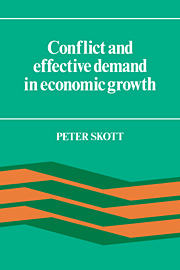Book contents
- Frontmatter
- Contents
- Guide to text notation
- Acknowledgements
- 1 Introduction
- 2 Methodological issues
- 3 A survey of some post-Keynesian and neo-Marxian ideas
- 4 The model
- 5 Ultra-short-run, short-run and steady-growth equilibria
- 6 Investment, instability and cycles
- 7 Finance and money-wage neutrality
- 8 Distributional questions in neo-Marxian and post-Keynesian theory
- 9 Final remarks
- Bibliography
- Index
7 - Finance and money-wage neutrality
Published online by Cambridge University Press: 05 January 2012
- Frontmatter
- Contents
- Guide to text notation
- Acknowledgements
- 1 Introduction
- 2 Methodological issues
- 3 A survey of some post-Keynesian and neo-Marxian ideas
- 4 The model
- 5 Ultra-short-run, short-run and steady-growth equilibria
- 6 Investment, instability and cycles
- 7 Finance and money-wage neutrality
- 8 Distributional questions in neo-Marxian and post-Keynesian theory
- 9 Final remarks
- Bibliography
- Index
Summary
INTRODUCTION
Keynesian theory has always regarded investment as a key variable. Firms decide the level of investment, and income and saving then adapt to bring about the ex post identity between saving and investment. But can investment plans be independent of saving? Firms need finance in order to execute their investment plans, and the availability of finance – or loanable funds – has been linked to saving by many economists.
Unlike in most Keynesian models I have specified the financial side of the economy in some detail, and the need to finance investment has been introduced explicitly. Short-term finance, however, has not been an active constraint: by assumption firms could borrow as much as they wanted at the prevailing rate of interest. Alternatively, they could use the new-issue market to raise finance: new and old securities are perfect substitutes, and new issues remain a possible source of additional funds even if financial markets take a dim view of the investment project which needs to be financed.
But is the specification of the financial environment and of the financial behaviour of firms satisfactory? In pre-Keynesian economics saving was seen as a constraint on investment – investment in fact was not always distinguished as a separate category – and similar views are common today: the widespread belief, for instance, that government spending must ‘crowd out’ private investment is based on the assumption that somehow the amount of saving (and finance) is given.
- Type
- Chapter
- Information
- Conflict and Effective Demand in Economic Growth , pp. 114 - 140Publisher: Cambridge University PressPrint publication year: 1989



